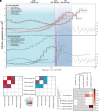Genomic analysis reveals a cryptic pangolin species
- PMID: 37748052
- PMCID: PMC10556634
- DOI: 10.1073/pnas.2304096120
Genomic analysis reveals a cryptic pangolin species
Abstract
Eight extant species of pangolins are currently recognized. Recent studies found that two mitochondrial haplotypes identified in confiscations in Hong Kong could not be assigned to any known pangolin species, implying the existence of a species. Here, we report that two additional mitochondrial haplotypes identified in independent confiscations from Yunnan align with the putative species haplotypes supporting the existence of this mysterious species/population. To verify the new species scenario we performed a comprehensive analysis of scale characteristics and 138 whole genomes representing all recognized pangolin species and the cryptic new species, 98 of which were generated here. Our morphometric results clearly attributed this cryptic species to Asian pangolins (Manis sp.) and the genomic data provide robust and compelling evidence that it is a pangolin species distinct from those recognized previously, which separated from the Philippine pangolin and Malayan pangolin over 5 Mya. Our study provides a solid genomic basis for its formal recognition as the ninth pangolin species or the fifth Asian one, supporting a new taxonomic classification of pangolins. The effects of glacial climate changes and recent anthropogenic activities driven by illegal trade are inferred to have caused its population decline with the genomic signatures showing low genetic diversity, a high level of inbreeding, and high genetic load. Our finding greatly expands current knowledge of pangolin diversity and evolution and has vital implications for conservation efforts to prevent the extinction of this enigmatic and endangered species from the wild.
Keywords: pangolins; population genomics; species delimitation.
Conflict of interest statement
The authors declare no competing interest.
Figures




References
-
- Wu S. B., Ma G. Z., Tang M., The status and conservation of pangolins in China. TRAFFIC East Asia Newsl. 4, 1–5 (2007).
-
- Challender D. W. S., Harrop S. R., MacMillan D. C., Understanding markets to conserve trade-threatened species in CITES. Biol. Conserv. 187, 249–259 (2015).
-
- Nijmana V., Zhang M. X., Shepherd C. R., Pangolin trade in the Mong La wildlife market and the role of Myanmar in the smuggling of pangolins into China. Glob. Ecol. Conserv. 5, 118–126 (2016).
-
- Choo S. W., et al. , A collective statement in support of saving pangolins. Sci. Total Environ. 824, 153666 (2022). - PubMed
Publication types
MeSH terms
LinkOut - more resources
Full Text Sources

